Blue Skies, but Why?
Special Stories
24 Jan 2018 6:06 AM
BLUE SKY
On days like this, and I know I do
You may just wonder what makes the sky blue
It’s really quite simple but harder to say
First was described by the math guy Rayleigh
It seems like air molecules small as they are
Will scatter the light from our nearest star
The shorter the wavelength in the spectrum of light
The more it will scatter into our eyesight
Mostly the blue light is scattered around
That’s what we see from here on the ground
Of course all of this may not be earth shattering
Blue skies are blue do to Rayleigh scattering
-Mike Morrison
Nothing nicer, even to a weather forecaster, than blue skies and sunshine. The sunlight from our nearest star is made up of numerous colors of various wavelengths when combined together gives us the bright “white” light that brightens our days.
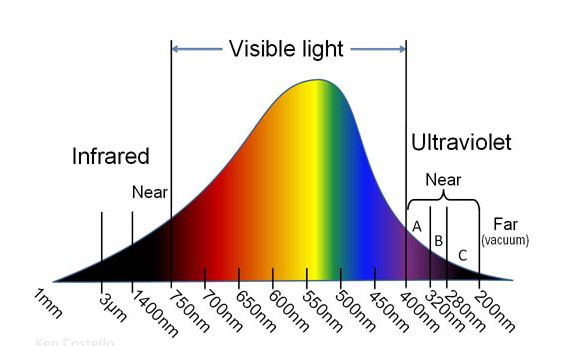 The blue skies that we see are actually courtesy of the atmosphere surrounding the earth.
The blue skies that we see are actually courtesy of the atmosphere surrounding the earth.
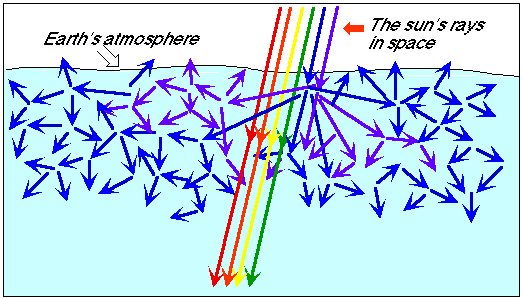 The earth’s atmosphere acts as a diffuser and scatters light from the sun. Longer wavelengths of the visible spectrum will scatter less than shorter wavelengths.
The earth’s atmosphere acts as a diffuser and scatters light from the sun. Longer wavelengths of the visible spectrum will scatter less than shorter wavelengths.
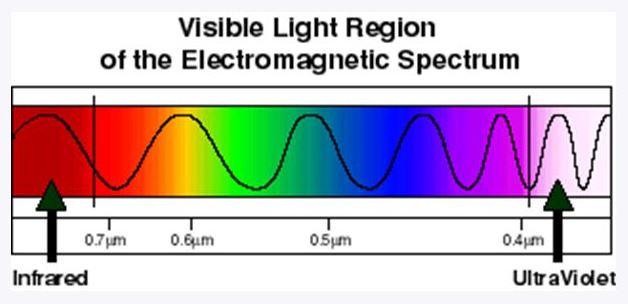 The result of this diffusion we call Rayleigh Scattering. This is the scattering of light or other electromagnetic radiation by particles much smaller than the wavelength of the radiation.
The result of this diffusion we call Rayleigh Scattering. This is the scattering of light or other electromagnetic radiation by particles much smaller than the wavelength of the radiation.
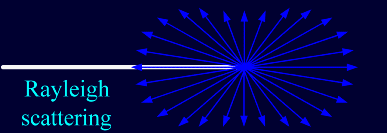 The molecules of air in our atmosphere are smaller than the wavelength of the visible wavelengths of sunlight which is perfect for Rayleigh Scattering. These air molecules will scatter sunlight in all directions. The shorter wavelengths of blue light is scattered more than longer wavelengths. That is why the air above us looks blue.
The molecules of air in our atmosphere are smaller than the wavelength of the visible wavelengths of sunlight which is perfect for Rayleigh Scattering. These air molecules will scatter sunlight in all directions. The shorter wavelengths of blue light is scattered more than longer wavelengths. That is why the air above us looks blue.
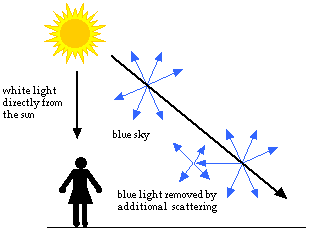 So why isn’t the sky colored violet? The sky is not violet because sunlight is weaker in violet spectrum compared to blue spectrum and the eye is less sensitive to violet light.
The best environment for blue skies is high pressure and dry, clean air through a deep part of the atmosphere. This setup in the atmosphere reduces another type of light scattering know as Mie Scattering which will dull a brilliant blue sky to a milky blue.
So why isn’t the sky colored violet? The sky is not violet because sunlight is weaker in violet spectrum compared to blue spectrum and the eye is less sensitive to violet light.
The best environment for blue skies is high pressure and dry, clean air through a deep part of the atmosphere. This setup in the atmosphere reduces another type of light scattering know as Mie Scattering which will dull a brilliant blue sky to a milky blue.
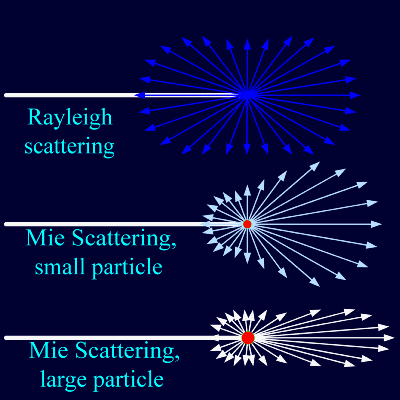
 The blue skies that we see are actually courtesy of the atmosphere surrounding the earth.
The blue skies that we see are actually courtesy of the atmosphere surrounding the earth.
 The earth’s atmosphere acts as a diffuser and scatters light from the sun. Longer wavelengths of the visible spectrum will scatter less than shorter wavelengths.
The earth’s atmosphere acts as a diffuser and scatters light from the sun. Longer wavelengths of the visible spectrum will scatter less than shorter wavelengths.
 The result of this diffusion we call Rayleigh Scattering. This is the scattering of light or other electromagnetic radiation by particles much smaller than the wavelength of the radiation.
The result of this diffusion we call Rayleigh Scattering. This is the scattering of light or other electromagnetic radiation by particles much smaller than the wavelength of the radiation.
 The molecules of air in our atmosphere are smaller than the wavelength of the visible wavelengths of sunlight which is perfect for Rayleigh Scattering. These air molecules will scatter sunlight in all directions. The shorter wavelengths of blue light is scattered more than longer wavelengths. That is why the air above us looks blue.
The molecules of air in our atmosphere are smaller than the wavelength of the visible wavelengths of sunlight which is perfect for Rayleigh Scattering. These air molecules will scatter sunlight in all directions. The shorter wavelengths of blue light is scattered more than longer wavelengths. That is why the air above us looks blue.
 So why isn’t the sky colored violet? The sky is not violet because sunlight is weaker in violet spectrum compared to blue spectrum and the eye is less sensitive to violet light.
The best environment for blue skies is high pressure and dry, clean air through a deep part of the atmosphere. This setup in the atmosphere reduces another type of light scattering know as Mie Scattering which will dull a brilliant blue sky to a milky blue.
So why isn’t the sky colored violet? The sky is not violet because sunlight is weaker in violet spectrum compared to blue spectrum and the eye is less sensitive to violet light.
The best environment for blue skies is high pressure and dry, clean air through a deep part of the atmosphere. This setup in the atmosphere reduces another type of light scattering know as Mie Scattering which will dull a brilliant blue sky to a milky blue.

All Weather News
More